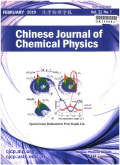- 钛学术文献服务平台 \
- 学术期刊 \
- 基础科学期刊 \
- 化学期刊 \
- 化学物理学报(英文版)期刊 \
Ionization and Dissociation of Benzene and Aniline under Deep Ultraviolet Laser Irradiation
Ionization and Dissociation of Benzene and Aniline under Deep Ultraviolet Laser Irradiation
基本信息来源于合作网站,原文需代理用户跳转至来源网站获取
摘要:
We report a study on photo-ionization of benzene and aniline with incidental subsequent dissociation by the customized reflection time-of-flight mass spectrometer utilizing a deep ultraviolet 177.3 nm laser.Highly efficient ionization of benzene is observed with a weak C4H3+ fragment formed by undergoing disproportional C-C bond dissociation.In comparison,a major C5H6+ fragment and a minor C6H6+· radical are produced in the ionization of aniline pertaining to the removal of CNH· and NH· radicals,respectively.First-principles calculation is employed to reveal the photo-dissociation pathways of these two molecules having a structural difference of just an amino group.It is demonstrated that hydrogen atom transfer plays an important role in the cleavage of C-C or C-N bonds in benzene and aniline ions.This study is helpful to understand the underlying mechanisms of chemical bond fracture of benzene ring and related aromatic molecules.

推荐文章
Deep web接口查询能力估计
查询接口
查询能力
Deep Web数据源自动分类
Deep Web
查询接口
朴素贝叶斯分类
一种Deep Web聚焦爬虫爬行策略
结构化Deep Web数据源
聚焦爬虫
决策树分类器
内容分析
关键词云
关键词热度
相关文献总数
(/次)
(/年)
文献信息
| 篇名 | Ionization and Dissociation of Benzene and Aniline under Deep Ultraviolet Laser Irradiation | ||
| 来源期刊 | 化学物理学报(英文版) | 学科 | |
| 关键词 | |||
| 年,卷(期) | 2020,(5) | 所属期刊栏目 | |
| 研究方向 | 页码范围 | 583-589 | |
| 页数 | 7页 | 分类号 | |
| 字数 | 语种 | 英文 | |
| DOI | 10.1063/1674-0068/cjcp2006086 | ||
五维指标
引文网络
引文网络
二级参考文献 (0)
共引文献 (0)
参考文献 (0)
节点文献
引证文献 (0)
同被引文献 (0)
二级引证文献 (0)
2020(0)
- 参考文献(0)
- 二级参考文献(0)
- 引证文献(0)
- 二级引证文献(0)
引文网络交叉学科
相关学者/机构
期刊影响力
化学物理学报(英文版)
主办单位:
中国物理学会
出版周期:
双月刊
ISSN:
1674-0068
CN:
34-1295/O6
开本:
大16开
出版地:
合肥中国科学技术大学化学物理学报编辑部
邮发代号:
创刊时间:
1988
语种:
eng
出版文献量(篇)
2451
总下载数(次)
0
总被引数(次)
8654
期刊文献
相关文献
推荐文献
- 期刊分类
- 期刊(年)
- 期刊(期)
- 期刊推荐
力学
化学
地球物理学
地质学
基础科学综合
大学学报
天文学
天文学、地球科学
数学
气象学
海洋学
物理学
生物学
生物科学
自然地理学和测绘学
自然科学总论
自然科学理论与方法
资源科学
非线性科学与系统科学
化学物理学报(英文版)2022
化学物理学报(英文版)2021
化学物理学报(英文版)2020
化学物理学报(英文版)2019
化学物理学报(英文版)2018
化学物理学报(英文版)2017
化学物理学报(英文版)2016
化学物理学报(英文版)2015
化学物理学报(英文版)2014
化学物理学报(英文版)2013
化学物理学报(英文版)2012
化学物理学报(英文版)2011
化学物理学报(英文版)2010
化学物理学报(英文版)2009
化学物理学报(英文版)2008
化学物理学报(英文版)2007
化学物理学报(英文版)2006
化学物理学报(英文版)2005
化学物理学报(英文版)2004
化学物理学报(英文版)2003
化学物理学报(英文版)2002
化学物理学报(英文版)2001
化学物理学报(英文版)2000
化学物理学报(英文版)2020年第6期
化学物理学报(英文版)2020年第5期
化学物理学报(英文版)2020年第4期
化学物理学报(英文版)2020年第3期
化学物理学报(英文版)2020年第2期
化学物理学报(英文版)2020年第1期

 免费查重
免费查重










